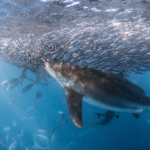Originally published: 11/4/2019 | flylordsmag.com | Click here for original article.

Croatia is a favorite holiday destination for many Europeans who are seeking a relaxing vacation with family. The country has so much to offer from the stunning Adriatic Coast with hundreds of beaches to the historical towns, and charming villages. With traditional culture still preserved and the delicious Mediterranean cuisine on the menu, it is one of my favorite places to visit.
For us flyfishers, one species comes to my mind to target in Croatia, the Mahi Mahi. The fish, also known as dorado or dolphin is as an acrobatic fighter with striking blue/yellow colors. Usually, you hear about them as a deep-sea pelagic species that live in the open ocean in tropical areas around the equator. But, Croatia can offer you something totally different. Mahi Mahi on the beaches and flats!
The last 20 years the temperature of Adriatic waters has been rapidly increased by global warming and fish species that weren’t there before, have begun to enter this area in large numbers.
Mahi in the Adriatic Sea started as nonnative predators but recently with global warming they have had a negative impact on local organisms in the sea. As the fastest growing fish in the ocean, they are irreversibly destroying local populations of Adriatic squids and needlefish. In good conditions, the fish can reach 1.3 to 2.7 inches a week up to 4 feet and 40 pounds in a single year! That is some rapid growth!
But all this aside they are a game fish that can be a blast to target and they taste really good as well. If you are interested in knowing more about these fish and how to target them you can follow these simple tips.
FIND THE RIGHT SPOT
When you fish for Mahi in Croatia the best way to start is to find a good spot where the water is rapidly dropping into deep or even better when you can find some ball of sardines or mullets around. Another option, which I personally prefer is to wade the shallow beaches, but this technique has several drawbacks. The biggest limitation is the tents of tourists, who are really curious, especially when you have fish on the other side of the line. For that reason, it is better to find your own place far away from swimming families.
The prime time is mid-July – mid-August when the water temperature is warmest. It actually doesn’t matter if you fish in the north or in the south of the country, but I most likely choose the bottom part of Croatia, due to the picturesque landscape and kind people down there.
USE RIGHT EQUIPMENT
Typically, you will not find bigger fish than 75 cm on the beaches but they are still very good fighters. The most important thing when it comes to proper equipment is the fly line and tippet.
I prefer the Rio Products Bonefish Quickshooter Fly Line. The line is primarily developed for bonefishing on flats, I would say this line is built for this kind of fishing. It works well for many reasons, but the primary purpose is to load your rod quickly and that’s exactly what you need. Usually, you will cast around 30 feet, but in a matter of seconds the school of Mahi can show up right in front of you and you have to hit them directly in the face.
I usually take a spool of 30lb, 25lb, 20lb, 16lb fluorocarbon tippet. Thicker fluoro tippet then 30lb will negatively affect the movement of your fly.
You also have to use reels with good working drag system and enough backing. These little Mahis’ will go into your backing usually and more backing is needed if you hit a good size bluefish on foot.
Remember, that fly fishing for Mahi in Croatia is hard work and it will take lots of patience. You can fish for hours, days without any strike, but when they suddenly show up you will experience one of the best fishing experiences of your life
When it comes to targeting these beauties, just remember there is no one perfect fly rod. Ironically, there are many perfect rods on the market, I personally fish Hardy HBX rods but their weight depends on the place and weather. When the wind cranks up you still need to cast long to bring fish closer, be prepared with an 8-weight rod, in normal conditions I suggest to use 7-weight rods, because the fight will be more enjoyable.
CHOOSING THE RIGHT FLY
Mahi Mahi in Croatia can feed on almost everything from little sardines, mullets, squids or seahorses. As the most common fly I use is the Surfcandy size 1/0-2/0 as an imitation of a sardine. But you can also use topwater poppers, which can be a lot of fun! The Mylar blue popper from Fulling Mill (pictured above) will do the job.
BE SURE TO STRIP FAST
Dolphin fish can swim at 50 MPH and leap to catch their prey. I never used such fast stripping anywhere else in the world than for Mahi. It’s because they are so curious and be careful do not let them check out your fly. Just move it as fast as possible.
If you decide to visit Croatia to get your first Mahi Mahi from the beach don’t forget to take in the whole experience. It can be easy that you will head back home with no fish caught but no matter what the pursuit will always drag you back to Croatia to fish for these colorful beasts on the sandy beaches!
Article by Katka Švagrová, a traveler, journalist, ambassador, and fly fishing guide at Hreggnasi Angling Club based in Iceland. Check her out on Instagram at @katka_svagrova. Additional photo credit to Vebjørn Kielland





